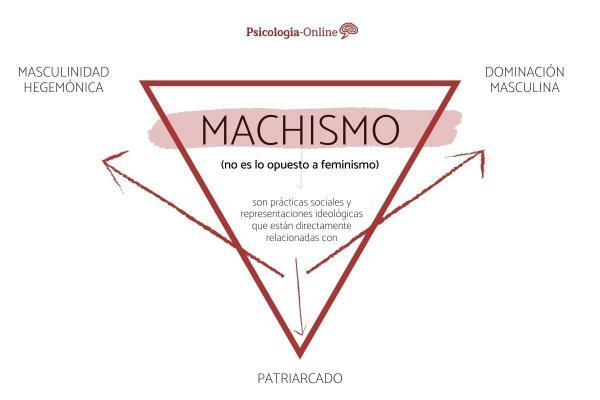
For some time now, we have often heard the expression "being macho", referring to actions or people. And the situations in which this term appears are as varied as possible, as well as their contexts and protagonists. The presence of this term in our vocabulary reflects how our society is structured and built.
To be a macho is to reproduce or act according to the logic of machismo, right? But what logic is that? How do you know if a situation is really machismo? In order for you to learn to identify machismo, you must know what is being macho. In this Psychology-Online article we will see what machismo is and how to identify sexist situations.
Index
- Sexism
- What is being macho
- How machismo affects men
- How machismo affects women in numbers
- How to identify a macho person
Sexism.
To understand what it means to be a sexist, it is essential to understand the broad concept of sexism and machismo. It is not difficult to see that this expression has the word 'male', but the meaning goes much further. Very briefly, machismo is a structural set of social practices and ideological representations that are directly related to the conception of
- 'Hegemonic' masculinity: it is the idea that there is a dominant, superior, heroic and self-sufficient masculinity. This concept can also be supported by its triple negation, that is, everything that a man should not be: a woman, a child or a homosexual person.
- Patriarchy: it is the social system that privileges and praises heterosexual white masculinity and reinforces gender roles.
- Male domination: it is the line of thought that supports hegemonic masculinity, patriarchy and, in turn, machismo. The sociologist Pierre Bourdieu was the one who worked on this concept in a book of the same name published in 1990. According to the theorist, male dominance is not always just about male-female gender distinctions, if not with all those differences that today represent oppositions, for example, rich and poor (class difference), colonizers and colonized, among others, and the unequal outcome of their relationships dichotomous.
Machismo in society
Machismo is such an impregnated and structured characteristic in society that it manifests itself in all social and cultural classes, with different characteristics.
Let us also make it clear that the machismo is not the opposite of feminism. Although they are words structured in the same way using nouns that represent different genders, the feminism It is a liberation movement that aims to achieve justice for the opportunities and rights of women in relation to men. Machismo, on the other hand, is a social structure that we were born into, and currently experience, that promotes inequality between people of different sexes.
What is to be macho.
It is much easier to understand what it is not to be macho than the other way around. This is because, as we explained, machismo is so structured and permeated in patriarchal society that from the moment we were born we experience a normalization of male dominance and its consequences, such as gender roles, stereotypes, sexual education, among others.
To the letter, being a macho is benefit from the privileges that this group grants to the oppressive side or reproduce this type of behavior. Most likely, machismo manifests itself unconsciously in each person. That is, people are sexist, but they do not know they are or perceive it.
Being sexist may or may not be conscious and is not always associated with people. The systems can be sexist, the laws, the impositions, the products of the culture industry, among many things. Machismo can and should be pointed out, but it does not need to be seen as a crime, but we must take into account Note that we were born in a macho society and that we must have an open mind to deconstruct these ideas.
Of construction
Starting from the point that we are all born in a sexist society, instead of pointing out levels of sexism (someone who is more or less sexist), it makes more sense think of people more or less deconstructed of this sexism. Deconstruction is a process of self-criticism, introspection and learning to understand that what seems normal, in reality is not.
How machismo affects men.
The machismo suffered by women is much more open, but machismo also affects men, although it is less well known. Machismo affects men because it can generate an inferiority complex in relation to characteristics exalted by the patriarchal system and hegemonic masculinity.
Some examples are these ideas that men cannot cry or show fear and other feelings, the fertility as a demonstration of masculinity and virility, among other aspects of what is now also they call toxic masculinity.
How machismo affects women in numbers.
But the numbers don't lie and women are the main victims of machismo. When it comes to racialized women, who are not heterosexual or cis gender, these statistics are even more alarming. These are some data related to gender inequality and violence published by Agência Gender and Number [1] and Agência Patrícia Galvão [2] that open the mortality of machismo and its consequences in relation to women and their intersectionality (gender, race, class, identification and sexual orientation):
- In 2017, 67% of the victims of physical assault in Brazil were women;
- In 2018, Brazil registered an average of 135 rapes per day;
- In 2018, the homicide rate is 71% higher among black women than white women;
- In 2019, 97% of women in a survey said they had already experienced sexual harassment in transportation;
- 3 women are victims of feminism every day;
- Every 2 minutes a woman registers assault under the Maria da Penha Law.
On the other hand, some statistical data for Spain according to the National Institute of Statistics are:
- Between 2008 and 2016, 67 men were killed by their partners, compared to 502 women.
- More than 2000 women who have died violently in the last 20 years.
- Of the 48 sentences handed down in 2016, 38 involved the murder of a woman (79%) and 10 of a man (21%).
- In 2017, 3,469 women were victims of sexual abuse compared to 584 men, in 98% of the cases, the abuser was a man.
- In 2017, 1,313 women suffered sexual assaults compared to 118 men, in 99% of cases the perpetrators were men.
See other data related to machismo and gender inequality in the publication that explains what is gender equality with examples.
How to identify a macho person.
Context and intersectionality are decisive factors when identifying a sexist act, speech or person. If you identify as a man, do not hesitate to ask a woman how she feels about this situation. Listen actively and respect the place of the speech.
Anyway, these are some questions that can be faced with the situation to find what 'smells like machismo':
- If we invert the genders in the roles of this situation, would the same thing happen?
- Is there some form of authoritarianism, superiority or domination in the relationships and acts present in the situation?
- Do all the people present have or have the same opportunities?
- Are there roles, stereotypes, and predetermined roles in this situation? Which and why?
Deconstruct
The above questions serve as a guide for a discussion on the topic and identification of sexist attitudes, ideas and people. If so, take the necessary measures (victim assistance, report ...) and practice deconstruction. This process consists of:
- Question the dominant group and its privileges.
- Self-criticism and personal introspection- Think about the male references you have had throughout your life.
- If you are part of this dominant oppressive group, try to view this situation from the point of view of vulnerability, with empathy. In this article we explain how to practice empathy.
- Recognize your mistakes and the pain that this violence causes.
- Go with an open mind to deconstruct you whenever an opportunity arises.
- Review these ideas and allow other people to deconstruct themselves as well.
After all, the first machismo that must be deconstructed is the one within us.
This article is merely informative, in Psychology-Online we do not have the power to make a diagnosis or recommend a treatment. We invite you to go to a psychologist to treat your particular case.
If you want to read more articles similar to What is being macho: definition and examples, we recommend that you enter our category of Social psychology.
References
- GENDER AND NUMBER. Gender violence map. Available at: < https://mapadaviolenciadegenero.com.br/ >. Retrieved July 20, 2020.
- PATRÍCIA GALVÃO AGENCIA. Available at: < https://agenciapatriciagalvao.org.br/ >. Retrieved July 20, 2020.
Bibliography
- GIRALDO, Octavio. Latin American Journal of Psychology. VOLUME 4 - NUMBER 3, p. 295-309 Machismo as a psychocultural phenomenon. 1972. Available in:. Retrieved July 16, 2020.
- GENDER AND NUMBER. Gender violence map: women are almost 67% of the victims of physical aggression in Brazil. July 11, 2019. Available at: < http://www.generonumero.media/mapa-da-violencia-de-genero-mulheres-67-agressao-fisica/ >. Retrieved July 20, 2020.


